
The Orpington is a British breed of chicken. It was bred in the late nineteenth century by William Cook of Orpington, at that time in Kent in south-east England. It was intended to be a dual-purpose breed, to be reared both for eggs and for meat, but soon became exclusively a show bird.

The Barnevelder is a Dutch breed of domestic chicken. It resulted from cross-breeding between local Dutch chickens and various "Shanghai" birds imported from Asia to Europe in the later part of the nineteenth century; these may have been of Brahma, Cochin or Croad Langshan type. It is named for the town and gemeente (municipality) of Barneveld, in Gelderland in the central Netherlands. The hens are good layers of large brown eggs and, unlike some other breeds, continue to lay well during winter.

The Dorking is a British breed of domestic chicken. It is named after the town of Dorking, in Surrey in southern England.

The Cochin is a breed of large domestic chicken. It derives from large feather-legged chickens brought from China to Europe and North America in the 1840s and 1850s. It is reared principally for exhibition. It was formerly known as Cochin-China.

The Indian Game is a British breed of game chicken, now reared either for meat or show. It originated in the early nineteenth century in the counties of Cornwall and Devon in south-west England. It is a heavy, muscular bird with an unusually broad breast; the eggs are brown.

The Malay Game is a breed of game chicken. It is among the tallest breeds of chicken, and may stand over 90 cm high.

The Sussex is a British breed of dual-purpose chicken, reared both for its meat and for its eggs. Eight colours are recognised for both standard-sized and bantam fowl. A breed association, the Sussex Breed Club, was organised in 1903.

The Scots Dumpy is a traditional Scottish breed of chicken. It is characterised by very short legs, so short that the body is a few centimetres from the ground; as in other breeds of creeper chicken, this chondrodystrophy is caused by a recessive lethal allele. The Dumpy has at times been known by other names, among them Bakie, Corlaigh, Crawler, Creeper and Stumpy. There are both standard-sized and bantam Scots Dumpies. It is one of two Scottish breeds of chicken, the other being the Scots Grey.

The Japanese Bantam or Chabo is a Japanese breed of ornamental chicken. It is a true bantam breed, meaning that it has no large fowl counterpart. It characterised by very short legs and a large upright tail that reaches much higher than the head of the bird.
The Taiwanese Game or Taiwan is a breed of large game chicken originating in the island of Taiwan, formerly known as Formosa. It is among the largest of chicken breeds, and may exceed 10 kg in body weight. It shows some similarity to large Japanese Shamo birds and, although it does not originate in Japan, may also be known as the Taiwanese Shamo. Large game chickens of this type but of indeterminate breed may sometimes be marketed as "Taiwan" or – in the United States – as "Saipan", "Saipan Jungle Fowl" or "Chinese Shamo".
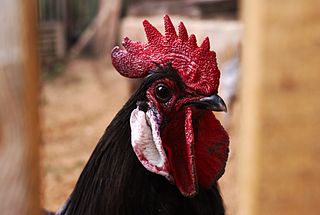
The Blue Andalusian, Spanish: Andaluza Azul, is a breed of domestic chicken indigenous to the autonomous community of Andalusia in south-west Spain. It is distributed through much of the countryside of Córdoba and Seville, and is concentrated particularly in the area of Utrera, which is considered the heartland of the breed. In 2009 the population was estimated at 10000 birds.
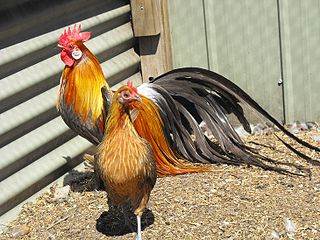
The Phoenix is a German breed of long-tailed chicken. It derives from cross-breeding of imported long-tailed Japanese birds similar to the Onagadori with other breeds.

The Modern Game is a British breed of ornamental chicken which originated in England between 1850 and 1900. It was bred from gamecock stock, but solely as an exhibition bird.

The Booted Bantam or Dutch Booted Bantam is a European breed of true bantam chicken. It is characterised by abundant feathering on the feet and shanks, which gives it a "booted" appearance; and by vulture hocks, long stiff downward-pointing feathers on backs of the thighs, from which the Dutch name Sabelpoot ("sabre-legged") derives.

The Kraienkopp or Twents Hoen is a breed of chicken originating on the border region between Germany and the Netherlands. The latter of the two names is the Dutch language version, while the former is German.
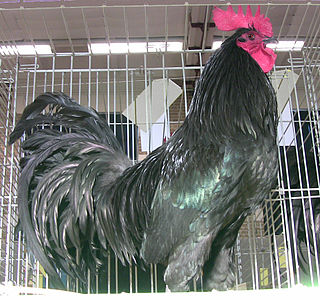
The Tōmaru (唐丸) is a Japanese breed of long-crowing chicken. The crow may be sustained for some 25 seconds. It is one of four Japanese long-crowing breeds, the others being the Koeyoshi, the Kurokashiwa and the Tōtenkō.
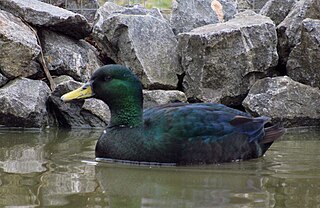
The East Indie or Black East Indian is an ornamental breed of domestic duck. It is a bantam breed, and is thought to have originated in the United States.
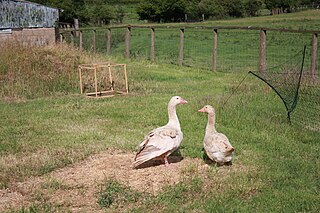
The Brecon Buff Goose is a breed of domestic goose originating in Wales.
The Shetland duck is a breed of domestic duck originating in the Shetland Islands of Scotland. It is critically endangered.
The Burmese or Burmese Bantam is a British breed of bantam chicken. It apparently originated in Myanmar, formerly Burma, in the latter part of the nineteenth century. By the time of the First World War it was thought to be extinct. Some surviving individuals were discovered in the 1970s and were bred with white Booted Bantams to recreate the breed.


















